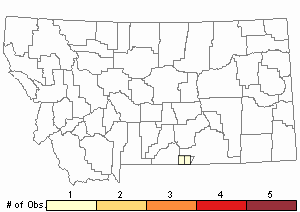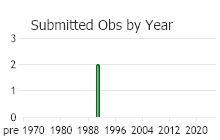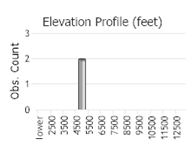View in other NatureServe Network Field Guides
NatureServe
Montana
Utah
Wyoming
Idaho
Wisconsin
British Columbia
South Carolina
Yukon
California
New York
Small Camissonia - Camissonia parvula
Other Names:
Oenothera parvula
State Rank Reason (see State Rank above)
Camissonia parvula is currently known from one extant location in Montana on the southern edge of the Pryor Mountains in Carbon County. Populations are thought to be small, but may vary widely from year to year. As an annual plant, it may tolerate - or even respond positively to - moderate levels of disturbance. Additional population and site data are needed for this species in Montana.
General Description
Small Camissonia is an annual herb with branching stems up to 15 cm high. The strap-shaped leaves are alternate and 1-3 cm long. Foliage is sparsely hairy to glandular. Small flowers are attached to the stem at the base of upper leaves. The four separate, yellow petals are 2-4 mm long, and the four sepals are reflexed. The stigma is ball-shaped. Petals and sepals are attached at the top of the ovary, which matures into a linear capsule, 2-4 cm long, that becomes twisted or coiled at maturity.
Phenology
Flowering and fruiting occur in May
Diagnostic Characteristics
Camissonia andina has white or pink flowers. Camissonia scapoidea has leafy stems and stalked fruits, whereas the fruits of C. parvula lack stalks. Camissonia minor has smaller petals than C. parvula.
Species Range
Montana Range
Range Descriptions

 Native
Native
Range Comments
WA to MT, south to CA, AZ, UT, CO. Known from Carbon County (Lesica et al. 2012. Manual of Montana Vascular Plants. BRIT Press. Fort Worth, TX).
Observations in Montana Natural Heritage Program Database
Number of Observations: 2
(Click on the following maps and charts to see full sized version)
Map Help and Descriptions
Relative Density

Recency



 (Observations spanning multiple months or years are excluded from time charts)
(Observations spanning multiple months or years are excluded from time charts)
Habitat
In Montana, Camassia parvula grows from 5200-5500 feet elevation on the southern edge of the Pryor Mountains. It occupies sandy soil weathered from calcareous sandstone, in ecotonal areas between juniper woodland and sagebrush steppe (Lesica and Achuff 1992). Associates include Juniperus osteosperma, Artemisia arbuscula, A. tridentata, Phacelia ivesiana, Streptanthella longirostris, Stipa comata, Bouteloua gracilis, and Gilia inconspicua.
National Vegetation Classification System Groups Associated with this Species
Forest and Woodland
Low Elevation - Xeric Forest and Woodland
Shrubland
Sagebrush Shrubland
Sparse and Barren
Sparse and Barren
Ecology
This plant is an annual, and population sizes may vary widely from year to year depending on conditions. Seeds can remain dormant in unfavorable years. The habitat is sparsely vegetated suggesting that the small plants are poor competitors for light, water or nutrients. Camissonia parvula may respond positively to moderate disturbance that reduces competition.
Management
As an annual plant, this species can likely tolerate and may respond positively to moderate levels of disturbance (Lesica and Achuff 1992). Populations are relatively small and localized, with the total occupied habitat in Montana estimated at about 2 acres.
Stewardship Responsibility
Threats or Limiting Factors
STATE THREAT SCORE REASON
Threat impact not assigned because threats are not known (MTNHP Threat Assessment 2021).
References
- Literature Cited AboveLegend:
 View Online Publication
View Online Publication Lesica, P., M.T. Lavin, and P.F. Stickney. 2012. Manual of Montana Vascular Plants. Fort Worth, TX: BRIT Press. viii + 771 p.
Lesica, P., M.T. Lavin, and P.F. Stickney. 2012. Manual of Montana Vascular Plants. Fort Worth, TX: BRIT Press. viii + 771 p. MTNHP Threat Assessment. 2021. State Threat Score Assignment and Assessment of Reported Threats from 2006 to 2021 for State-listed Vascular Plants. Botany Program, Montana Natural Heritage Program, Helena, Montana.
MTNHP Threat Assessment. 2021. State Threat Score Assignment and Assessment of Reported Threats from 2006 to 2021 for State-listed Vascular Plants. Botany Program, Montana Natural Heritage Program, Helena, Montana.
- Additional ReferencesLegend:
 View Online Publication
View Online Publication
Do you know of a citation we're missing? Lesica, P. and P. F. Stickney. 1994. Noteworthy collections: Montana. Madrono 41:228-231.
Lesica, P. and P. F. Stickney. 1994. Noteworthy collections: Montana. Madrono 41:228-231. Lesica, P. and P.L. Achuff. 1992. Distribution of vascular plant species of special concern and limited distribution in the Pryor Mountain desert, Carbon County, Montana. Unpublished report to the Bureau of Land Management. Montana Natural Heritage Program, Helena, MT. 105 pp.
Lesica, P. and P.L. Achuff. 1992. Distribution of vascular plant species of special concern and limited distribution in the Pryor Mountain desert, Carbon County, Montana. Unpublished report to the Bureau of Land Management. Montana Natural Heritage Program, Helena, MT. 105 pp. Lesica, P., M.T. Lavin, and P.F. Stickney. 2022. Manual of Montana Vascular Plants, Second Edition. Fort Worth, TX: BRIT Press. viii + 779 p.
Lesica, P., M.T. Lavin, and P.F. Stickney. 2022. Manual of Montana Vascular Plants, Second Edition. Fort Worth, TX: BRIT Press. viii + 779 p. Quire, R.L. 2013. The sagebrush steppe of Montana and southeastern Idaho shows evidence of high native plant diversity, stability, and resistance to the detrimental effects of nonnative plant species. M.Sc. Thesis. Bozeman, MT: Montana State University. 124 p.
Quire, R.L. 2013. The sagebrush steppe of Montana and southeastern Idaho shows evidence of high native plant diversity, stability, and resistance to the detrimental effects of nonnative plant species. M.Sc. Thesis. Bozeman, MT: Montana State University. 124 p.
- Web Search Engines for Articles on "Small Camissonia"





